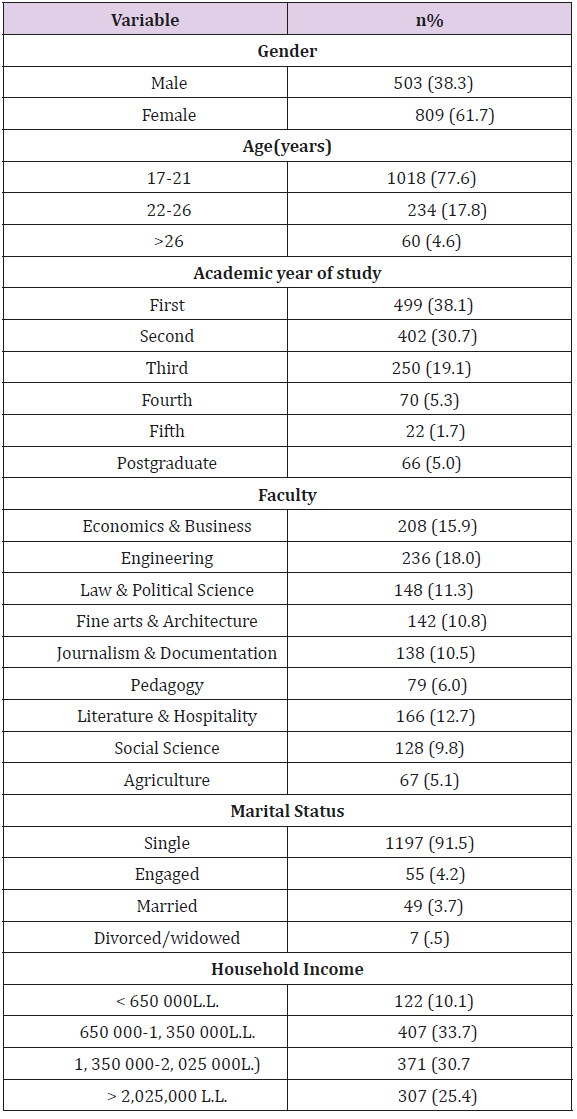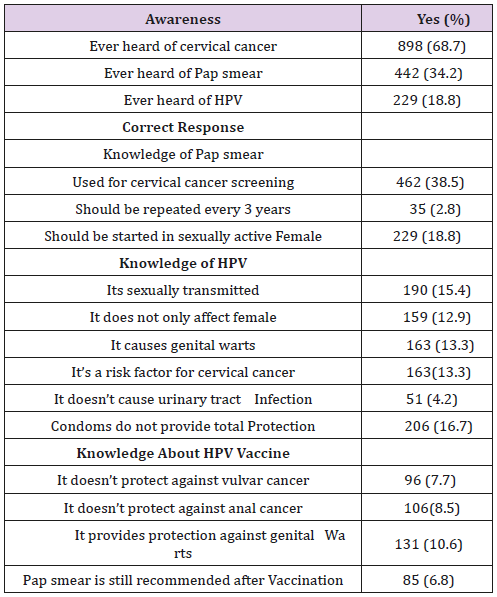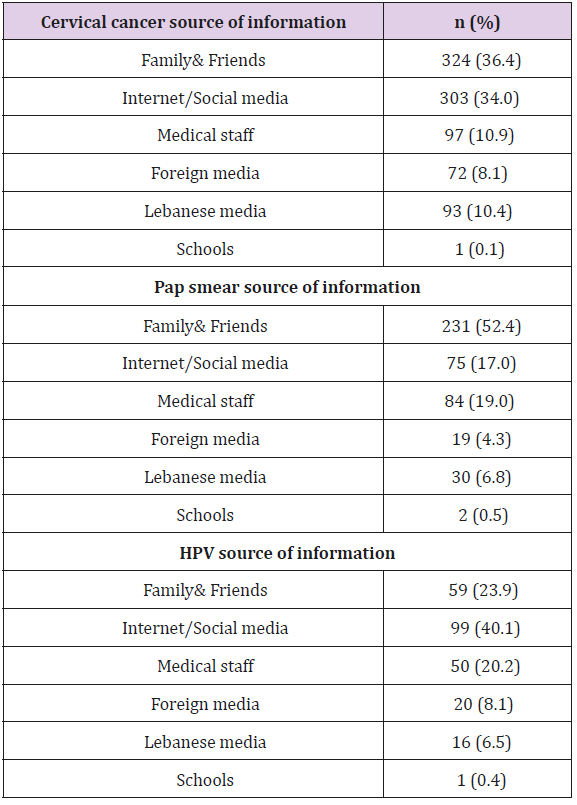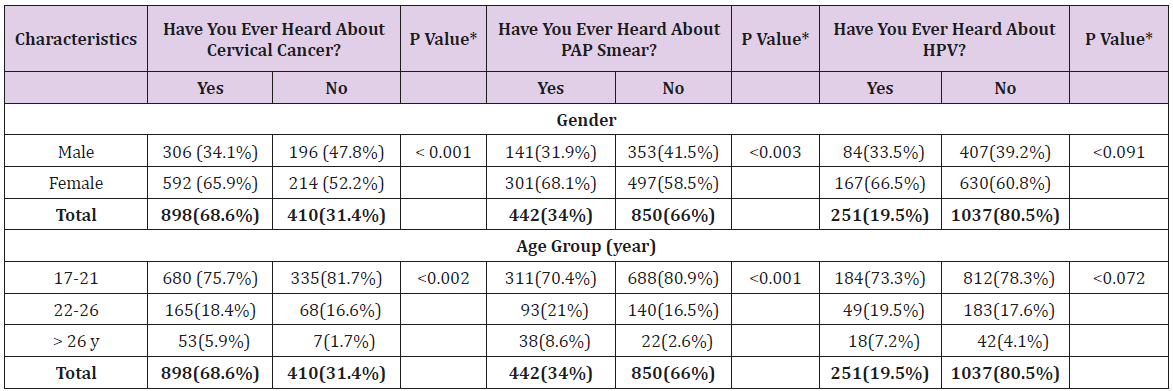Abstract
Introduction: This study aimed to assess current knowledge and beliefs towards cervical cancer, Pap smear and HPV vaccine in young students at the Lebanese university.
Methods: A self-administered questionnaire was administered in June 2018, to 1312 students of 9 nine different faculties of the Lebanese university. Data collected included: socio-demographic characteristic, awareness and knowledge of cervical cancer, Pap smear and HPV and the source of information that students mostly use.
Result: Our participants were mainly female (61.7%), single (91%) and in the first two academic years (70%). Only 68.7 %, 34.8% and 19.5% of the students had ever heard of cervical cancer, Pap smear and HPV respectively. The two-principal source of information were “Family /Friends” and “Internet/Social media”.
Conclusion: This study is one of the first to assess the knowledge of cervical cancer, Pap smear and HPV altogether in the Lebanese students and to focus on the source of information used. The knowledge among students was generally low. Continued efforts are further needed for a well-designed educational program in order to increase awareness and decrease mortality rate related to cervical cancer.
Introduction
Cervical cancer is the fourth most common cancer in women and the seventh overall, with an estimated 528,000 new cases and 266,000 deaths in 2012 worldwide, accounting for 7.5% of all female cancer deaths [1]. Likewise, Human papillomavirus (HPV) infection is extremely common. Although genital HPV infection is difficult to estimate, current figures suggest that visible genital warts are present in approximately 1 % of sexually active adults in the united states and that at least 15% have subclinical infection as detected by HPV DNA assays [2].The correlation between the presence of this virus and the development of precancerous lesions that may lead to cervical cancer is clearly established [3].
In fact, the world health organization recommends vaccinating 9- 13 years old girls with 2 doses of HPV vaccine to prevent HPV infection and also recommends HPV test to screen for cervical cancer [4]. Despite these recommendations and the high prevalence of cervical cancer, women’s knowledge remains very low [4-7]. Regarding Lebanon, small studies showed conflicting results. In fact, one investigation conducted on a small group of Lebanese women in 2012, showed 5 % aged between 18 and 76 years carries the virus, which is less than the western countries, but similar to the Mediterranean countries [8]. Another research paper demonstrated that the rate of infection instead of decreasing was constant between 2010 and 2014, which is probably due to the western traditions that have influenced our adults [9]. Furthermore, concerning Lebanese women awareness, one survey conducted on urban Lebanese women, showed lack of knowledge and only 17 % of female aged between 18 and 35 years to be vaccinated [10], however another study showed that the Lebanese women were actually aware of Pap smear and HPV infection, yet they would not practice screening due to the feeling of embarrassment, cost and accessibility [11]. In order to resolve this dilemma, we decided to conduct a study on a big mass of Lebanese college students to assess their actual awareness and what method is best used to improve their knowledge.
Methods
This is a cross-sectional survey conducted in multiple faculties of the Lebanese university across Lebanon, in June 2018.We extended the survey to areas of geographical proximity and socioeconomic/ religious equivalence, including Tripoli city in the North Governorate of Lebanon, the neighborhood of the capital [ Fanar, Roumyeh.] and the Capital Beirut. A 23-item, self-administered, anonymous, pretested, structured questionnaire with closed-ended questions was used to obtain data. The formation of our questionnaire was based on previously validated and reliable tools from the literature and adapted to our society culture [12-14].
Our tool written in English and Arabic and was tested on a
sample of 30 university students to ensure clarity, appropriate
wording, and ease of administration. Data of the pilot test were not
included in this study.
Our questionnaire targeted the following information:
a) The sociodemographic and socioeconomic features of
students.
b) The awareness/knowledge of the students about cervical
cancer, HPV mode of transmission, HPV vaccine (the questions
related to awareness were asked if the person has ever heard of
the issue) and Pap smear screening and importance.
c) The source of information, which students mostly use.
In order to decrease the bias in our study as much as possible,
we excluded a number of faculties that can interfere with the results
of our study. In fact, we excluded the faculty of Medical Sciences,
faculty of Dentistry, faculty of Pharmacy, faculty of Sciences and the
faculty of public health.
Study Design and Ethical Permission
This cross-sectional study used a KAP survey based on validated and reliable tools from the literature [12-14], conducted in June 2018. After getting their verbal consent, 1312 Lebanese university students from non-medical faculties were targeted to participate in this survey. Participants were invited to complete a designed and customized survey in Arabic and English language about their knowledge, attitudes and practices regarding HPV, Pap smear and cervical cancer. The Institutional Review Board at the Lebanese University granted us permission to conduct this study. Questionnaires were coded and data entered on SPSS, version 24. Data entry was then controlled, and data analyzed using the same software. Missing values which accounted less than 10% of answers were not replaced and variables were analyzed as available. Descriptive statistics mainly means were used for continuous variable and proportions were used for discrete variables. Univariate analysis was performed to obtain measures of frequency of variable such as socio-demographic characteristics. A p-value <0.05 was considered significant. The chi square test was used for comparison between categorical variables.
Result
General Characteristics: (Table 1)
Our Sample size was 1312, where the majority was female 61.7% vs 38.3% of males (fq: 809 vs 503), aged between 17 to 22 y/o (77.6%).The questionnaire was randomly assigned among nine faculties with their different branches, where the response rate was equally distributed between 10% -15% except for the Agriculture faculty which had a response rate of 5 %. More than half of participants (70% approximately) were in the first two academic years. Moreover, 91 % of the Students were single, and only 10 % had a monthly household income of less than the minimal wage.
Awareness Rate (Table 2)
Upon questioning the students about Cervical Cancer, 68.7% showed knowledge regarding this topic. Half of those hardly (34.8%) were aware of Pap smear, and among those only 38.5% knew that it’s use for cervical cancer screening. Infact 50.2 % had no idea what Pap smear is used for, and the remaining 11 % thought it was used to prevent sexually transmitted diseases or genital tract infection. Additionally, 97.2% did not know when it should be repeated, 44% were clueless when it should be started and solely 18% were aware that it should be started in sexually active women. Furthermore, one-fourth barely (19.5%) have heard about HPV, just 15 % knew that it was sexually transmitted while 77% did not know. Plus, 12.1 % thought it affects women exclusively, while 75% were unaware. Additionally, 84.2 % did not know if it causes genital warts and 81.2 % did not know if it increases the risk of cervical cancer. In Fact, 16 % believed it increases the risk of urinary tract infection, whereas 79.9% mentioned that they don’t know. Adding to that, 11.1 % mentioned that condoms provide TOTAL protection; nevertheless 72.2% did not know. Also, 13.5% believed that HPV vaccine protects against vulvar cancer, yet 78.8% did not know; and 7.7% believed that it protects from anal cancer however 83.3% did not know. Finally, 6.7 % believed that Pap smear screening is not necessary after HPV vaccine, but 86.5% did not know.
Source of Information (Table 3)
The two main source of information for cervical cancer were “family and friends” (36.4%) followed by “Internet/ Social media” (34%). The primary source of information for Pap smear was also “family and friends” (52.4%), succeeded by “medical staff” (19%) and “Internet/Social Media” (17%). Concerning HPV, the leading source of information was “internet/Social media” (50%) then “family/Friends” and “Medical staff” with a percentage of 23.9% and 20.2% respectively. Overall, schools, universities and Lebanese media were the least to provide any source of knowledge to our young generations (Table 3).
Variable Analysis
As mentioned earlier 34.4 % of our participants have never heard of cervical cancer, of whom 52.2% were female and 47.8% were male (p <0.001). Also 66% did not hear of Pap smear, from which 58.5% were female and 41.5 % were male (p <0.003). Among students aged between 17-22 years, 66% have heard of cervical cancer (p <0.002), however 68% have not heard of Pap smear (p <0.001). Regarding the marital status, 67% of single students and 87% of married people were aware about cervical cancer (p<0.019); 67.7% of single students lacked knowledge concerning pap smear but only 31% of married people were clueless relating to this subject (p<0.001). (Table 4)
Discussion
In our study, we included university students since they reflect the principles and ideology of the Lebanese population as a whole, and because they are affected the most by the technology expansion and the rapid westernization occurring in Lebanon. Moreover, we chose the “Lebanese university” because it embraces a large number of students with different socioeconomic levels and religious beliefs. Our Results showed that the greater number of students were female, with the majority aged between 17 and 21y/o, in the first two academic years, and single. Nearly all students were aware of cervical cancer per se, however they were clueless of what causes it (i.e. HPV) and how to prevent it with Pap smear or HPV vaccine. To mention that students older than 26 years old, married, or divorced/widowed were more knowledgeable regarding Pap smear.
Less than one fifth of the students had ever heard of HPV infection. This is lower than what was observed in similar study done in Italy (23.3%) [15], Finland (33%) [16], Florida (78%) [17] and Malaysia (85%) [18]. Student’s level in the university also had an association with the awareness. Similarly, a study in Brazil showed respondents with higher educational attainment were more likely to have a better knowledge [19]. Our study is the first in Lebanon to examine the source of information that students use most. In Fact, we demonstrated that the two main sources are “family and friends” and “The Internet/Social Media”. The same as studies in Florida which showed similar results considering these methods commonly utilized for leisure by young adults and could also be used to disseminate information [15,19]. Unfortunately, an important issue is often neglected which is the essential quality of our society which is considered conservative, religious despite the recent westernization. In fact, the majority refuses pre-marital relationships and considers with HPV vaccine an access for these relationships. Hence the necessity of education which is of huge importance.
What are the Methods Required to Fix This Problem?
The lack of knowledge revealed in our study can be improved
with few simple methods:
First, increase the Family doctors/ Pediatricians/ Gynecologist’s
accentuation and emphasis on the importance of cervical
cancer screening, and prevention through HPV vaccines starting at
young age.
Second, the Lebanese health ministry has a major role by:
a) Healthcare campaigns with free Pap smear screening.
b) Lebanese social media/advertisement, which was proven
in our study to be tremendously fragile.
c) Reducing the price of HPV vaccine / making the
vaccination mandatory.
d) Adding more information in schools and universities
curriculum.
All these methods and many more will have a tremendous effect
not only on the prevalence of cervical cancer, but also on its early
detection in the Lebanese population.
Limitations and Strengths
Our study is the first to study the knowledge of cervical cancer, Pap smear and HPV altogether in a considerable sample size of young college students, in different Lebanese districts. We are also the very first to study the source of information students used in order to improve their medical awareness. However, we have few limitations; first we did not ask about sexual activity of our students, since this can affect tremendously their knowledge. Second, we should have separated Family from Friends in the source of information category, to have a more precise idea on the Family’s role per so toward this topic. Additionally, a potential limitation that should be considered when interpreting this study is that the information obtained was collected using a self-administered questionnaire and so possibly exists that some respondents may have given incorrect information. Finally, we did not encounter their accessibility to Pap smear and HPV vaccine, and the obstacles preventing students with adequate knowledge from engaging in these preventive measurements.
Conclusion
The level of awareness about cervical cancer, Pap smear and HPV in our studied population was significantly low. The two main sources of information were “family and Friends” and “Internet/ Social media” whereas Lebanese media, schools and universities had no role in educating our students. Further studies are needed to monitor the amelioration in education and to shed more light on the numerous obstacles facing the Lebanese society preventing them from easy accessibility to Pap smear and HPV vaccine.
Acknowledgement
None.
Conflict of Interest
No conflict of interest.
References
- Ferlay J, Soerjomataram I, Dikshit R, Eser S, Mathers C, et al. (1993) Cancer Incidence and Mortality Worldwide: source, methods and major patterns in GLOBOCAN 2012. Int J Cancer 136 (5): E359-386.
- Koutsky L (1997) Epidemiology of Genital Human Papillomavirus Infection. Am J Med 102(5A) : 3-8.
- Seoud M, Tjalma WA, Ronsse V (2011) Cervical adenocarcinoma: Moving towards better prevention. Vaccine 29(49): 9148-9158.
- World Health Organization (2014) Comprehensive cervical cancer control: A guide to essential practice, 2nd (Edn.).
- Tebeu PM, Major AL, Rapiti E, Petignat P, Bouchardy C, et al. (2008) The attitude and knowledge of cervical cancer by Cameroonian women; A clinical survey conducted in Maroua, the capital of Far North Province of Cameroon. Int J Gynecol Cancer 18(4): 761-765.
- Getahun F, Mazengia F, Abuhay M, Birhanu Z (2013) Comprehensive knowledge about cervical cancer is low among women in Northwest Ethiopia 13 (2).
- Francis SA, Nelson J, Liverpool J, Soogun S, Mofammere N, et al. (2010) Examining attitudes and knowledge about HPV and cervical cancer risk among female clinic attendees in Johannesburg, South Africa 28 (50): 8026-8032.
- Mrouweh AM, Seoud MA, Kaspar HG, Zallouwa PA (2002) Prevalence of genital human papillomavirus among Lebanese women. Eur J Gynaecol Oncol 23(5): 429-432.
- El Homsi M, Aftimos G, Tofaily Z, Hassan K (2016) The risk of developing cervical cancer in Lebanon. World journal of Pharmacy and Pharmaceutical sciences 5 (7): 18-30.
- Choucair JE (2016) What do Lebanese women know about cervical cancer and human papillomavirus? A report on awareness in urban communities. International Journal of infectious disease 53:145.
- Sakr R, Adib S (2001) P1-314 Knowledge, perceptions, and practices concerning pap smear screening for cervical cancer in Lebanon. BMJ journals, journal of epidemiology & community Health 65 (1).
- Makwee CC, Anorlu RI, Odeyemi KA (2012) Human papillomavirus (HPV) infection and vaccines: Knowledge,attitude and perception among female students at the university of Lagos, Lagos Niegeria. J epidemiol Glob Health 2(4): 199-206.
- Saulle R, Miccoli S, Unim B, Semyonov L, Giraldi G, et al. (2014) Validation of a questionnaire for young women to assess knowledge, attitudes and behaviors toward cervical screening and vaccination against HPV: Survey among Italian sample. Epidemiol Biostat Public Health 11(2):1-12.
- Pelucchi C, Eposito S, Galeone C, Semino M, Sebatini C, et al. (2010) Knowledge of human papillomavirus infection and its prevention among adolescents and parents in the greater Milan area, Northern Italy. BMC public health 10(1): 378.
- Di Giuseppe G, Abbate R, Liguori G, Albano L, Angelillo IF (2008) Human papillomavirus and vaccination: knowledge, attitudes, and behavioural intention in adolescents and young women in Italy. Br J Cancer 99(2): 225-229.
- Woodhall SC, Lehtinen M, Verho T, Huhtala H, Hokkanen M, et al. (2007) Anticipated acceptance of HPV vaccination at the baseline of implementation: a survey of parental and adolescent knowledge and attitudes in Finland. J Adolesc Health 40(5): 466-469.
- Gerend MA, Magloire ZF (2008) Awareness, knowledge, and beliefs about human papillomavirus in a racially diverse sample of young adults. J Adolesc Health 42(3): 237–242.
- Wong LP, SamIC (2009) Ethnically diverse female university Students, knowledge and attitudes toward human papillomavirus (HPV), HPV vaccination and cervical cancer. Eur J Obstet Gynecol Reprod Biol 148(1): 90-95.
- Moreira Jr ED, Oliveira BG, Ferraz FM, Costa S, Costa Filho JO, et al. (2006) Knowledge and attitudes about human papillomavirus, Pap smears, and cervical cancer among young women in Brazil: implications for health education and prevention. Int J Gynecol Cancer 16(2): 599-603.

 Short Communication
Short Communication



